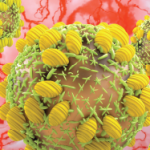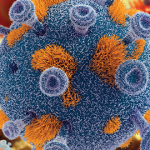Following exposure, HCV infection resolves in an estimated 15% to 40% of patients, with the remainder progressing to chronic infection.6 The virus has a short half-life and turns over an estimated 10 to 12 billion particles per day, contributing to ongoing immune activation. Longitudinal studies suggest that, while the outcomes of patients may differ depending on study design, 75% to 80% of patients will not succumb to HCV complications and only 15% to 20% will progress to cirrhosis and die of associated complications (see Figure 1, p. 18).6 The time frame for such progression in most patients is over several decades or more. Physicians need to know these data because a detailed discussion of such issues with an infected patient can help allay fears about the disease. Of concern, however, is the small percentage of patients who rapidly progress to end-stage liver disease and its complications, including those with associated immunosuppressive illnesses (i.e., human immunodeficiency virus [HIV] infection or other immunodeficiencies) and heavy consumers of alcohol. Thus, testing and behavioral modification of alcohol consumption is recommended.
Predicting progression of liver damage is not straightforward, since there are no efficient noninvasive strategies currently widely endorsed; biopsy remains the gold standard to assess disease severity and progression.7 Newer non-invasive strategies evaluating liver fibrosis are currently being investigated, including serum fibrosis biomarkers and imaging modalities such as the transient or magnetic resonance elastography.8 Up to 30% of patients may have persistently normal or near normal liver enzymes and yet a significant portion of these individuals can have advanced fibrosis or even cirrhosis on biopsy. Viral load quantification by polymerase chain reaction (PCR) is widely available but also does not predict outcome other than response to antiviral therapy.
The standard treatment regimen for chronic hepatitis C is combination therapy with pegylated interferon-a (IFN-a) with ribavirin given for six to 12 months. This regimen achieves viral clearance in 42% to 80% of patients.7 Factors associated with a favorable response to antiviral therapy include the virus genotype (there is a better responses in genotypes -2 and -3 compared with genotype-1), low pre-treatment viral load (≤ 2×106 copies/ml), young age, and a good virologic response after three months of therapy (≥ 2-log decline in HCV RNA levels from baseline).7
Table 1: Essential Facts about HCV for the Rheumatologist
Biology
- Taxonomy: RNA virus member of the Flaviviridae family
- Size: 9.6 kb
- Replication rate: In excess of 10 billion particles per day
Epidemiology and Transmission
Globally distributed chronic infection
- 170 million infected worldwide
- 2.9 million in the United States
Modes of HCV Transmission
- IVDU or intranasal drug use
- Blood products/tissue transplants before 1992
- High-risk sexual activity
- Nosocomial or occupational transmission
- Tattoos, body piercing
- Shared personal items with infected individuals
- Mother to infant
Clinical Features
- Most frequently asymptomatic
- 15% to 40% clear infection within six months
- 60% to 85% chronically infected
- 20% with chronic HCV infection develop cirrhosis leading to hepatocellular carcinoma, decompensation, or death
- Chronically infected patients may have normal liver enzymes 30% of the time
Diagnosis
- HCV antibody by EIA as initial screen
- If EIA is positive, follow with HCV RNA
- If HCV RNA is positive, patient is chronically infected
- If HCV RNA is negative patient is probably not infected; repeat RNA testing in six to 12 months
Does HCV Infection Confound RA Diagnosis?
HCV can impede the diagnosis of RA, particularly in the early stages, in several ways. First, it is now well known that HCV infection is frequently accompanied by rheumatoid factor (RF) activity that can be of high titer; thus, false-positive RF tests should always raise the possibility of HCV infection. Secondly, patients with HCV infection can manifest a variety of articular signs and symptoms that could be confused with true RA.9 In general, HCV-infected patients have symmetric polyarthralgias more commonly than frank synovitis and erosive changes do not occur. Finally, several studies have documented that HCV infected patients have a low frequency of anti-CCP antibodies, suggesting that high-titer anti-CCP in an HCV infected patient with polyarthritis is more likely to represent true RA.
Which RA Patients Should Be Screened for HCV Infection, and How?
Screening strategies for chronic blood-borne viral infections in general (i.e., HCV, hepatitis B virus [HBV], and HIV) are controversial and ever changing and should prompt rheumatologists to reassess their own role in the patient screening process. Official recommendations for rheumatologists are limited, but the RA treatment guidelines of the ACR recommend only testing for HCV and HBV in patients at “high risk” among those being put on methotrexate or leflunomide.10 Clearly, such practices need revision. Nonbiologic DMARD therapy has not been extensively studied in the HCV infected population, but limited data suggest a high incidence of hepatotoxity with many agents traditionally thought safe.11

